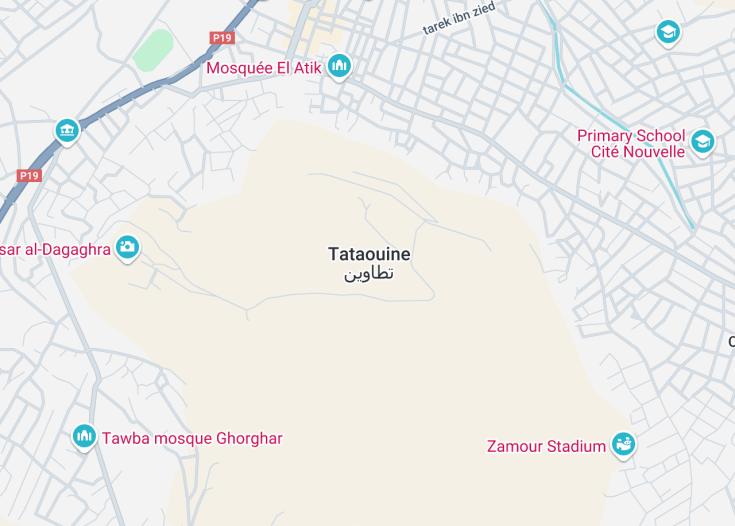Tataouine, located in the far southeast of Tunisia, is an enchanting destination famed for its dramatic desert landscapes and unique cultural heritage. This spot inspired the name of the planet Tatooine in the Star Wars saga, making it a must-visit for fans.
The area is dotted with ancient ksour (fortified granaries), offering a glimpse into the storied past of the Berber communities that have thrived here for centuries. Visitors can explore the rugged terrain, discover traditional Berber architecture, and experience the rich cultural tapestry that makes Tataouine truly unforgettable.
Travel light and wear comfortable footwear. The terrain in Tataouine can be challenging, and the climate is typically hot and dry, making hydration and sun protection crucial.
Consider visiting during the local Ksour Festival, usually held in the spring. It’s a wonderful opportunity to experience Tataouine’s culture, including music, dance, and traditional crafts.
Visit Enigmatic Tataouine: Where Earth Meets the Stars
| Country | Tunisia |
| Time in Tataouine | GMT+1 |
| Language spoken | Arabic |
| Population | 125,000 (as of 2023, source: Statista) |
| Currency | Tunisian Dinar (TND) |
| Airports |
|
Tataouine, located in the far southern part of Tunisia, is a fascinating town with a population of about 125,000. It is known for its unique desert landscapes and as a filming location for some iconic Star Wars scenes.
Its history is equally engaging, with influences from various cultures over the centuries, including Berber, French, and Arab. Tataouine’s Ksar quarters, traditional mud-brick buildings, and the annual Ksour Festival draw visitors from around the world, offering a glimpse into the region’s rich heritage and traditional architecture. Additionally, its proximity to the Sahara offers spectacular views and thrilling desert excursions, making it a gem for adventurers and culture enthusiasts alike.
Where is Tataouine?
Positioned in the southeast of Tunisia, Tataouine is a jewel of the desert that charms with its historic aura and captivating landscapes.
Distances:
| Route | Distance by Car | Time by Car |
|---|---|---|
| Tunis to Tataouine | 537 km | 6 hours 8 minutes |
| Sousse to Tataouine | 400 km | 4 hours 30 minutes |
| Sfax to Tataouine | 300 km | 3 hours 30 minutes |
| Gabès to Tataouine | 127 km | 1 hour 30 minutes |
What is Tataouine famous for?
Tataouine is internationally renowned not only as the name inspiration for Star Wars’ Tatooine but also for its captivating ksour (fortified granaries) that dot the desert landscape, offering a view into a storied past.
History
Prehistoric Period to Roman Era
From as early as prehistoric times, the area now known as Tataouine in Tunisia was inhabited by various indigenous tribes who utilized the region’s caves and rocky outcrops for shelter. By the 1st century AD, Tataouine became part of the vast territories controlled by the Roman Empire, serving as a minor outpost in the province of Africa. It featured typical Roman architectural elements, including a fort that was utilized for monitoring and securing the trade routes traversing the desert.
Islamic Conquests to Ottoman Rule (7th Century – 1881)
With the spread of Islam in the 7th century, Tataouine witnessed significant cultural and administrative changes. It became integrated into the powerful Islamic caliphates, including the Umayyad and later the Abbasid. By the 15th century, the region was under the control of the Ottoman Empire, which fortified the town further and used it as a strategic military base to exert control over the Sahara trade routes.
French Colonial Period (1881-1956)
The late 19th and early 20th centuries marked a period of French colonial influence in Tataouine. The French administrative and military presence brought new infrastructure, including roads and public buildings, significantly altering the town’s layout and architecture. This era also saw Tataouine become a place of exile for political prisoners, which added a complex layer to its historical tapestry during French rule.
Post-Independence Era (1956 to Present)
Since Tunisia gained independence in 1956, Tataouine has navigated the paths of modernization and development while striving to preserve its rich cultural heritage. Today, it is known not only for its historical significance but also as a tourist destination, attracting visitors fascinated by its ancient ksour (fortified granaries) and stunning desert landscapes.
Visit Tataouine
What to see and do in Tataouine
Explore the captivating town of Tataouine, renowned for its unique cultural heritage and striking desertscapes. Key attractions include:
- The Ksar Ouled Soltane: one of the best-preserved granary fortresses in the region.
- Chenini and Douiret: ancient Berber villages carved into the mountainside, offering a glimpse into traditional architectural styles.
- The Tataouine Market: a vibrant marketplace where visitors can experience local life and purchase traditional crafts.
Adventurous travelers can also embark on desert safaris that showcase the region’s dramatic landscapes and provide opportunities for unforgettable experiences under the stars.
Festivals and Events in Tataouine
Experience the rich cultural tapestry of Tataouine through its annual events, including the Festival of Ksour Saharien. Held in March, this festival celebrates the region’s architectural heritage, featuring traditional music, dance, and local cuisine. Visitors in spring can enjoy this vibrant celebration that highlights the cultural unity and diversity of Tataouine’s communities.
Best time to visit Tataouine
For a pleasant travel experience, the best time to visit Tataouine is during the cooler months from October to April. During this period, the temperatures are mild, making it ideal for exploring the outdoor historical sites and participating in the cultural festivals.
Is Tataouine worth visiting?
Indeed, Tataouine is well worth a visit, especially for those interested in history, culture, and natural beauty. The town offers a unique combination of historical sites, traditional lifestyles, and stunning landscapes that are unlike anywhere else in the world.
Its preserved ksour and ancient Berber villages provide an extraordinary insight into the past, while its vibrant cultural festivals offer a taste of its rich traditions and welcoming community.









